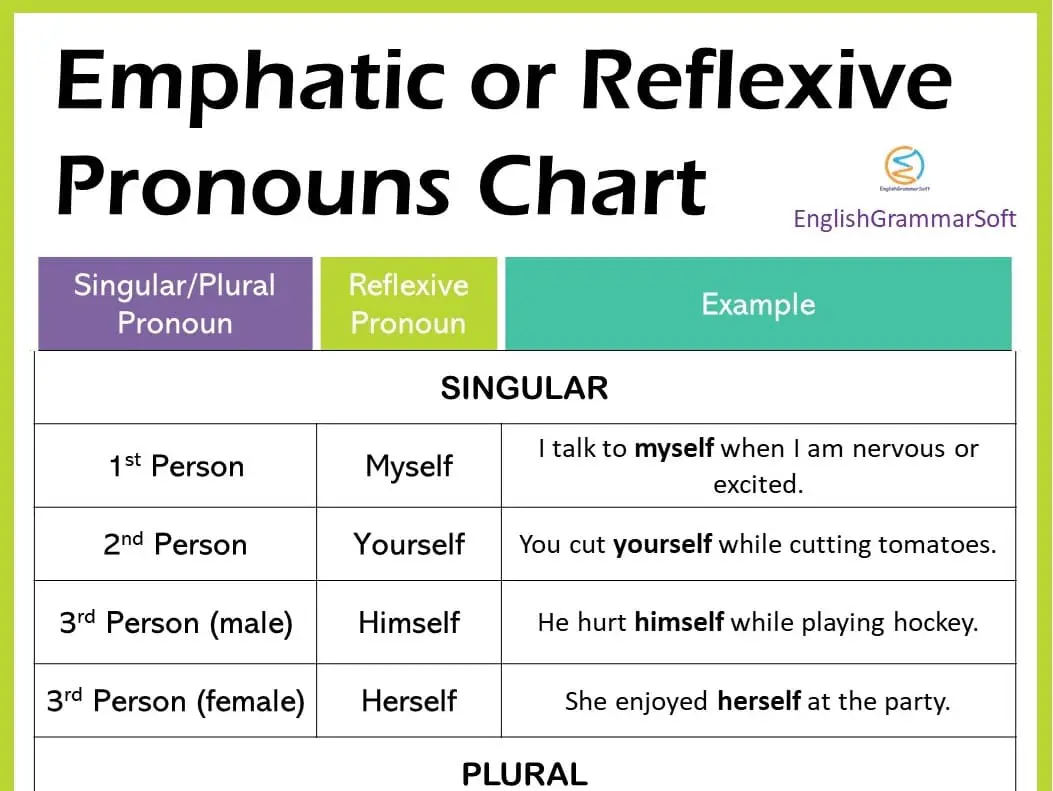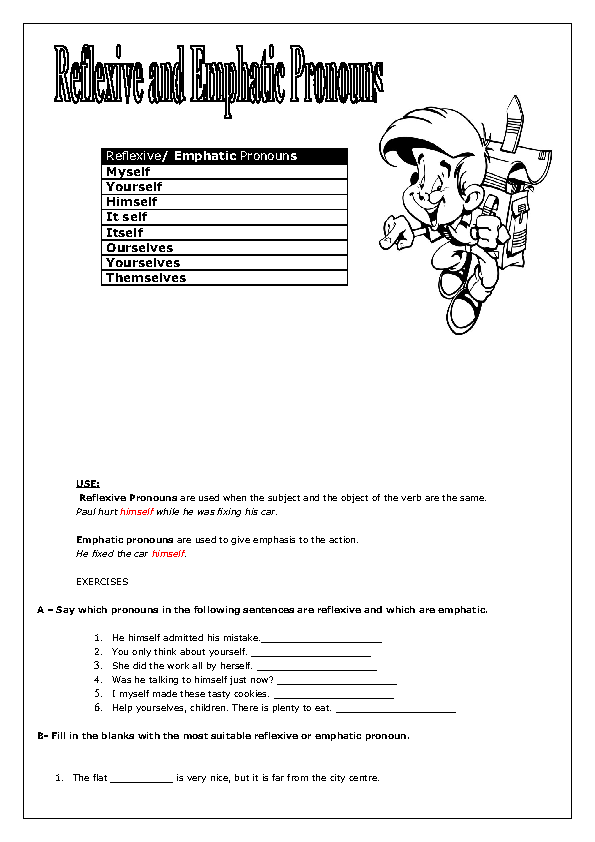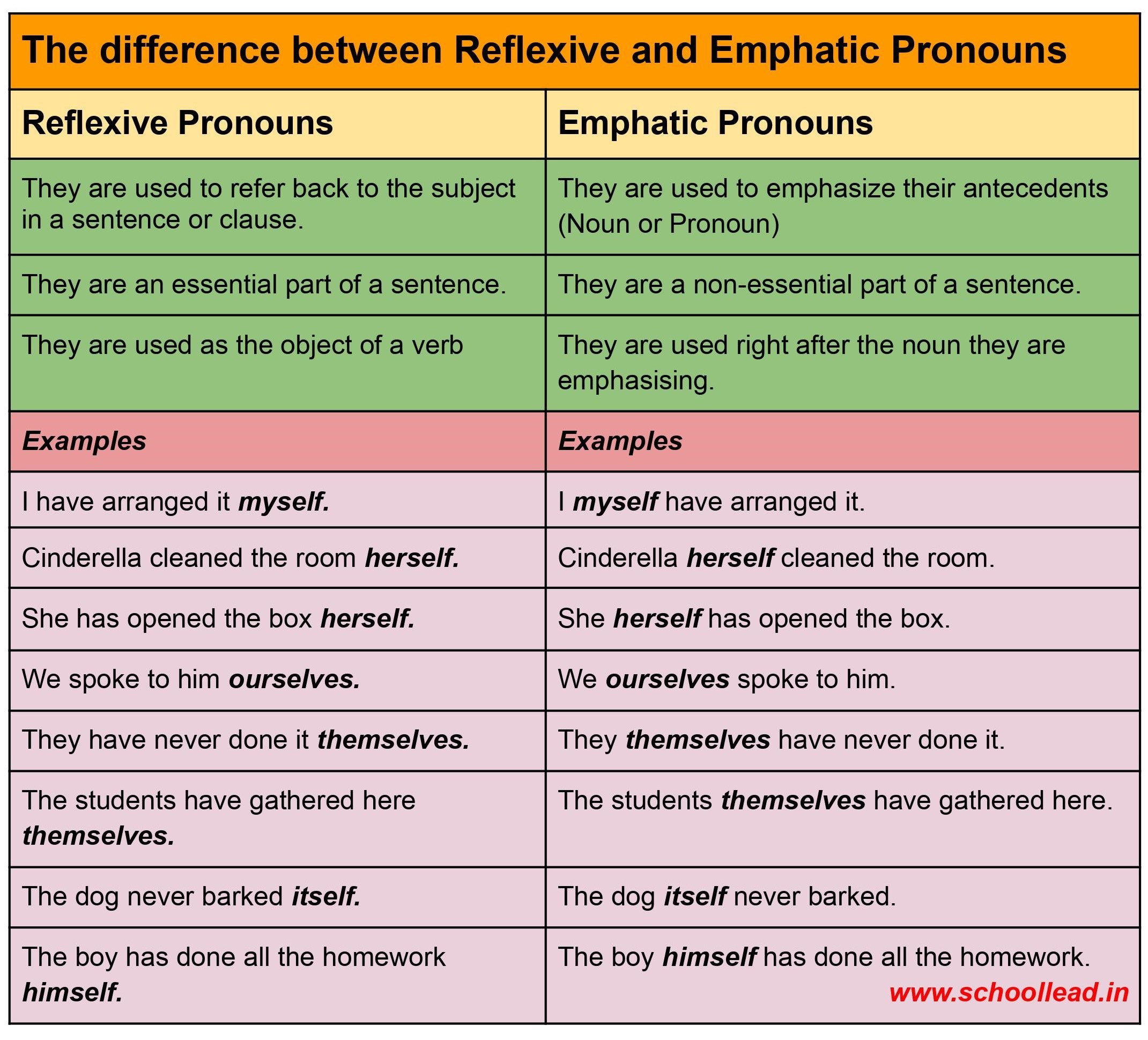
What is Emphatic Pronoun Difference between Emphatic & Reflexive Pronoun Pronoun Part 8
Did you notice the difference between the use of '-self. Differentiating between a reflexive pronoun and an emphatic pronoun could be a little more effort. Many students tend to get confused when asked to distinguish between the two. But not anymore! We have simplified this differentiation for you with relevant examples.

Emphatic or Reflexive Pronouns (Chart, 80+ Examples & List) EnglishGrammarSoft
In this video, you will learn - The difference between Reflexive and Emphatic Pronouns.- How to identify both in the given Sentences.- Easy technique to iden.

Emphatic Pronouns Explanation and Examples
An emphatic pronoun is used for emphasis. Actually, your sentence has double emphasis because you've also added "in person". The emphatic pronouns are the same as the reflexive pronouns. The sentence does not seem to need a comma. It's not a list, there is no direct speech or address. It's not two sentences linked with "but" , or a dependent or.

Reflexive and Emphatic Pronouns YouTube
The main difference between an emphatic pronoun and a reflexive pronoun is that an emphatic pronoun indicates and lays emphasis on the fact that an action was done without any help, whereas, a reflexive pronoun reflects back to the noun or pronoun doing the action in the sentence.

DIFFERENCE BETWEEN REFLEXIVE AND EMPHATIC PRONOUN YouTube
The difference between Reflexive and Emphatic Pronouns: They are used to refer back to the subject in a sentence or clause. They are used to emphasize their antecedents (Noun or Pronoun) They are an essential part of a sentence. They are a non-essential part of a sentence.

Difference Between Reflexive Pronoun And A Emphatic Pronoun In A Easy Way KalaisLifestyle22
Differences between Reflexive Pronoun and Emphatic Pronoun Difference 1. While a reflexive pronoun reflects the action of the subject upon the subject itself, an emphatic pronoun just emphasizes the action of the subject. A reflexive pronoun answers the question : whom ? He cut himself. [himself - reflexive pronoun, since the subject's (i.e.

Emphatic or Reflexive Pronouns (Chart, 80+ Examples & List) EnglishGrammarSoft
Reflexive pronouns serve as the object of a transitive verb when the object is the same person or thing as the subject (e.g., 'I believe in myself '). Emphatic pronouns (also called intensive pronouns) are used in combination with another noun or pronoun to place special emphasis on it ('I myself wrote the code').

Difference between Reflexive & Emphatic Pronoun. YouTube
Reflexive Pronoun: Emphatic Pronoun (1) The action done by the subject reflects upon the subject: He killed himself. (1) Emphatic Pronoun is generally in apposition with another word : I myself saw the man. (2) It refers to the subject: They hurt themselves (2) It cannot stand alone as a subject: She herself did the work. (3) It is generally placed after a verb or preposition:

Reflexive and Emphatic Pronoun with example/ Difference between both YouTube
Placement: Reflexive pronouns are generally placed after the verb or after the object of the sentence. For example: She cut herself. They blamed themselves for the mistake. Emphatic pronouns are placed after the subject and before the verb or after the verb. For example: I myself witnessed the incident.

Emphatic Pronouns and difference between Emphatic and Reflexive pronouns in English by T
This animation teaches the learner to define and identify reflexive and emphatic pronouns in given sentences.This is a product of Mexus Education Pvt. Ltd.,.

Reflexive and Emphatic Pronouns in English My Lingua Academy
Solution. Reflexive pronouns demonstrate that the subject's action has an effect on the doer. An emphatic pronoun, on the other hand, merely accentuates the subject's activity. Although reflexive and intense pronouns have the identical appearance, they perform quite distinct purposes in sentences. A reflexive pronoun refers to the sentence.

emphatic pronouns exercises with answers
The difference between the two constructs is whether it is necessary for the specific meaning (then it's reflexive) of the sentence or can be omitted without changing the actual meaning (then it's emphatic).. In your particular sentence: I did it myself. if you omit "myself", then the meaning (that "it" was "done" by you) still remains:I did it. So, the pronoun is emphatic.

Reflexive and Emphatic Pronouns Worksheet
The main difference between reflexive and emphasising pronouns is that reflexive pronouns reflect the action back on the subject while emphasizing pronouns emphasise the noun or pronoun being referred to.. The difference between reflexive pronouns and emphasising pronouns mainly depends on their function. The formulations of these pronouns are the same: you only have to add "-self" or.

Reflexive and Emphatic Pronouns School Lead
The pronouns myself, yourself, herself, himself, itself, ourselves and themselves are not, at their base, emphatic pronouns. BUT one of the uses of these very same words is as emphatic pronouns. (Emphatic use). She, herself, received the prize. (non-emphatic use) She gave herself a pat on the back.

Difference between reflexive and emphatic pronouns exercises
Difference Between Reflexive and Emphatic Pronouns. Differentiating between a reflexive pronoun and an emphatic pronoun is not much difficult but it can be tricky. If you got confused, we have simplified this differentiation for you with examples in sentences. Hope, after reading it, you will be able to differentiate reflexive pronouns and.

Difference between Reflexive & Emphatic Pronouns Part2 YouTube
Reflexive pronoun s, are 'self' words which like a mirror reflect the action done by the subject on himself/ herself. They usually refer to an adverb , adjective , pronoun, or noun located within the same clause. They are usually used when the subject and the object of a sentence are the same-e.g, Oh! I hurt myself.